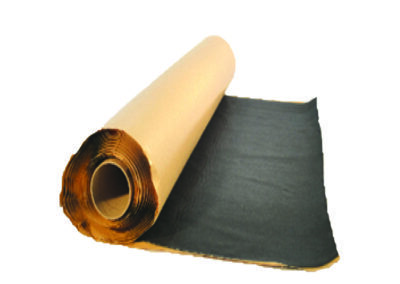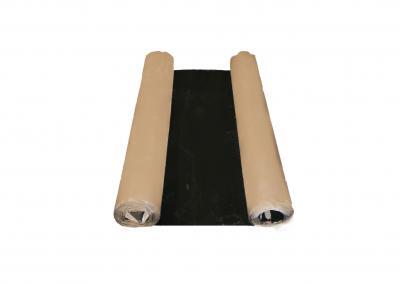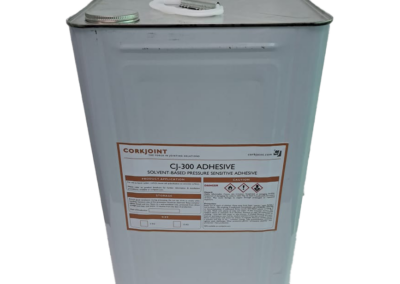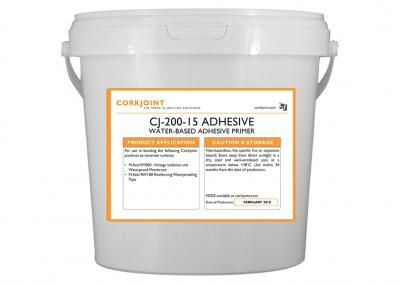M-SEAL® VM500
VOLTAGE ISOLATION AND WATERPROOF MEMBRANE
PRODUCT BROCHURE
Press X Arrow Toggle for Full Screen View
Product Description
CORKJOINT® M-SEAL® VM500 Voltage Isolation & Waterproof Membrane Sealing System is a self-adhesive butyl rubber based Voltage Isolation and Waterproof Membrane with a geotextile top layer, for use on slab and wall applications. Made from a special bitumen-free butyl rubber composition, the M-SEAL VM500 is an easy, clean and environmentally friendly solution for preventing the transfer of static electrical currents through concrete slabs and walls, in both wet and dry areas of application.
The self-adhesive layer of M-SEAL® VM500 bonds strongly to the existing substrate, while the concrete topping screed (secondary top layer) bonds tenaciously to the geotextile layer of the membrane. This dual bonding process prevents any separation between the substrate and the concrete topping screed which also helps maintain the quality and sustainability of the finished floor coverings.
M-SEAL® VM500 has high crack-bridging capabilities and due to the tenacious bonding of the slab, and the topping layer slab, to the geotextile membrane layer on the top of M-SEAL® VM500 membrane, it becomes a fully bonded membrane system to the substrate and the proceeding concrete layer, which also enables it to isolate, insulate and prevent the transfer of electrical currents and water through the concrete or via cracks in the concrete.
Advantages
- Provides excellent electrical insulation in both wet and dry conditions.
- A self-adhesive membrane with excellent adhesion to the concrete substrate, for both floor and wall applications. Use CJ-200-15 Adhesive Primer (water-based). No torch-on or hot-iron requirements needed for installation, so no harsh or hazardous fumes are created.
- Bonds to most types of surfaces (concrete, steel, ceramic, PVC pipe) with the use of CJ-200-15
Adhesive Primer. - Fast and easy to install compared to conventional membrane systems.
- A geotextile top layer for high performance bonding to concrete topping slabs and to screed coatings of various thicknesses. Also prevents the migration of water between membrane and finishes.
- Can withstand up to 5.73 x 10^14 ohm-cm at a thickness of 2.5mm.
- High crack bridging capabilities of up to 2mm.
- Produced from a special SBS Modified rubber composition with both the adhesive bottom layer and the geotextile top layer bonded during the manufacturing process.
- No bentonite present so the product does not expand and break-up in water and/or wash from the joint, removing the potential of voids between slab/wall and finishes. SBS Modified rubber gives long-term durability and integrity to the product and in-turn to the joint and substrate.
Areas of Application
- Railway station platform slabs and walls.
- Viaducts and Bridges.
- Power Stations and Utilities.
- Electrical Riser Rooms.
- Base slabs, walls and roofs for waterproofing (a topping slab must be applied)
Note : The product’s design and performance, its intended use, installation and final confirmation and approval for use, must be provided by the project’s Design Engineer and Project Manager.
Physical Properties
Refer to the Product Brochure for this information.
Typical Installations
- lean the concrete surface using a stiff brush or with high pressure air to remove any loose dirt and debris. Remove any exposed high or sharp points on the concrete surface, which may prevent the M-Seal® VM500 membrane from adhering fully to the surface or from being punctured. Any major holes or voids in the concrete surface should be filled with an application of a cement mortar in order to level the surface to the same level as the current concrete surface where the membrane is to be applied.
- For “horizontal slab surfaces,” apply a thin, even layer of CJ-200 Adhesive Primer onto a clean, dry, concrete surface, using a roller, brush or sprayer. Allow the CJ-200 Adhesive Primer to become tacky (approximate drying time is 10-20 minutes at 25°C and depending upon the current ambient temperature) before installing the M-Seal® VM500 membrane. The dosage rate should be at approximately 8 – 9m² per litre depending upon the concrete surface condition and porosity. A thorough, even and uniform coverage of the adhesive primer should be applied.
- Remove the release paper from the adhesive side of the M-Seal® VM500 membrane and apply the membrane onto the primed surface with the rubber section being applied directly on to the concrete primed surface.
- Press the entire surface of M-Seal® VM500 membrane firmly into place using a medium or hard surface roller to ensure full bonding of the membrane is achieved and to make sure that all air pockets are removed. Around edges, corners and difficult locations that cannot be applied with a roller, use a firm hand or finger pressure to apply the membrane. Additonal CJ-300 Adhesive Primer may be required to be applied at these locations to aid in the bonding and adhesion.
- For joining of the membrane, where the overlap sections of M-Seal® VM500 membrane meet, provide an overlap cover of the membrane to the already applied membrane, of not less than 100mm and firmly press the overlapping piece onto the underlying piece to fully seal the seam. The lapped section should be rolled firmly with a medium to hard roller to make sure that the rubber presses firmly into the geotextile layer and to remove any air pockets. Apply a thin uniformed application of CJ-300 Adhesive Primer onto the membrane at 100mm wide for the overlap section.
- For all “vertical surfaces” (wall, column and platform edge) and including the 100mm lap join of the membrane, apply a thin, even layer of CJ-300 Adhesive Primer onto a clean, dry, concrete surface, using a roller, brush or sprayer, and then allow it to be touch-dry for 10 minutes before applying or joining the next applied membrane section, also following the installation procedures under item no. 4. The use of CJ-300 Adhesive Primer provides extra bonding security, especially if a cement render is being applied externally onto the membrane.
- The M-Seal® VM500 membrane is now ready for the application of the topping slab or the wall cement render. Prior to applying the secondary concrete layer, especially for a topping slab, make sure that there are no stones or loose items on top of the membrane, and that it is fully clean and free of any loose dirt and debris. Check all areas of the membrane for damage and if found, follow the required repair methods under item no. 11.
- At and around special locations of the “Platform Screen Doors (PSD’s), Platform End Doors, Emergency Exits, Columns and Walls,” which may also include special coverings and requirements, the voltage isolation protection of these areas are to be undertaken by the installers/- suppliers of those systems and/or in conjuction with the specialist membrane installer. For special installation requirements for these areas, please refer to your project’s professional electrical engineer/consultant.
- For internal and external corner areas of slabs, walls and columns, detailing at platform screen doors (PSD’s), platform end doors, emergency exits etc. that may have overlaps of more than one or two membrane applications covering each other, then the use of CJ-300 Adhesive Primer should be applied to aid in the bonding and adhesion.
- CORKJOINT recommends that at all locations of the installed membrane, be immediately protected by installation of the topping slab or by appropriate installation protection boards/covers for slabs and walls, or cordoned off so at no time should the membrane be damaged, punctured, pierced, dislodged, subject to traffic of any type, otherwise its function and performance maybe compromised.
- After installation, if the membrane is damaged, compromised in anyway, pierced, broken, impacted or flattened by a heavy object, then apply an appropriate size patch of the same membrane over the area, the size is to be 100mm x 100mm wider than the widest damaged section/parts of the membrane, and then the membrane tested at that location to see if it resists the minimum required voltage isolation requirements. Prior to applying the repair patch, make sure that the membrane and any exposed surface is dry, clean, and free of dust and debris and apply a thin, even layer of CJ-300 Adhesive Primer onto the surface, allowing it to be touch dry for 10 minutes before applying the patch over it. Press the patch firmly into position with a firm hand or finger pressure, or with a medium or hard firm roller, to make sure that the rubber presses firmly into the geotextile layer of the first applied membrane and to remove any air pockets.
- CORKJOINT recommends that at specific required locations of the installed membrane, and as advised, confirmed and approved by the project’s Professional Electrical Engineer/Consultant and Main Contractor’s Project Manager, that the membrane is tested to the project’s specified minimum voltage isolation resistance requirements, upon installation of the membrane at the application area, upon installation of the topping slab or wall render, and also after installation of the floor or wall finish, to check that the installation of the membrane has been undertaken successfully.
Note: The above installation requirements and installation detailing, at all locations, must be approved and confirmed by the Project’s Professional Electrical Engineer/Consultant and by the site Main Contractor’s Project Manager, who have satisfied themselves that the membrane complies and conforms to their project’s installation and specification requirements.
CORKJOINT’s full Jobsite Installation Method & Procedures is available upon request.
Packaging and Dimensions
M-Seal® VM-500
- 2.5mm (thick) x 1.0 metre (wide) x 10.0 metre (long) roll
- Roll Weight: 28kg (approximately)
Adhesive Primer
- CJ – 200 : 20 litre pail
- CJ – 300 : 15 kg drum
Written Specification
The voltage isolation and waterproofing membrane where shown on the drawings, shall be M-Seal® VM500 as supplied by CORKJOINT. The membrane system must be a special SBS Modified rubber, have a maximum thickness of 2.5mm, be a fully bonded system that has self-adhesive properties for installation and have concrete crack-bridging capabilities of up to 2.0mm. The voltage electrical resistance levels must be >5.5 x 10^14 ohm-cm and testing must be carried out in accordance to ASTM D257 by a certified independent laboratory or Professional Electrical Engineer. The membrane is to be installed in accordance to the manufacturer’s required installation guidelines, and to the Design Engineer’s specification.
Health & Safety Information
For further information or advice on health and safety precautions, safe handling, storage and correct disposal of products, please refer to the most recent product Safety Data Sheet (SDS), which is available upon request.
Product Brochure Validity
CORKJOINT undertakes modifications to its product brochures on a continual basis, as and when required. Please check under the product summary section at www.corkjoint.com to ensure that youhave the latest version of our product brochures.
Disclaimer
The information and the recommendations relating to the application and end use of this product are given in good faith and are based on the information provided by the manufacturer of the product and/or the Company’s current knowledge and experience in connection with the product when properly stored, handled and applied under normal conditions and no liability of final function at the job site is assumed. In practice, the differences in materials, substrates and actual site conditions are such that no warranty in respect of merchantability of, or fitness for, particular purpose, nor any liability arising out of any legal relationship whatsoever, can be inferred either from this information, or from any written and/or oral recommendations, or from any other advice offered by the Company. The Company also has no express or implied knowledge of any particular purpose for which the product is required and any such information given will not be taken into account in the supply of this product. No responsibility or liability by the Company will be accepted for misuse, misreading or derivation from recommended guidelines in respect of this product and the user shall determine the suitability of the product for his intended use and assume all risks and liability in connection therewith. The information contained in our brochure may change at any time without notice. Any use of this product, M-SEAL® VM500, in any application should be approved as suitable for use/application by the Design Engineer and Project Manager.




